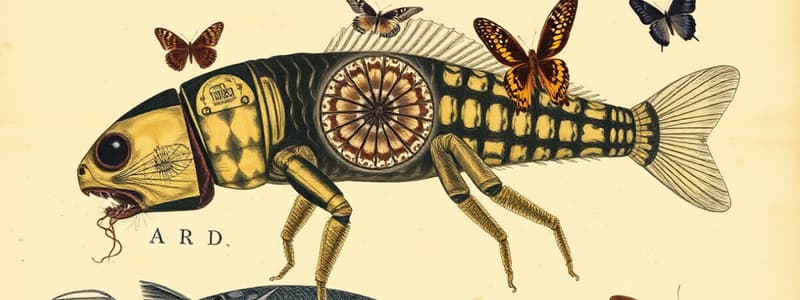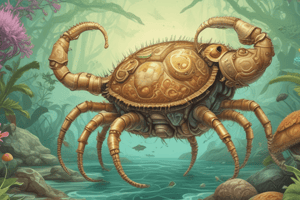Podcast
Questions and Answers
What is a key characteristic of the Porifera phylum?
What is a key characteristic of the Porifera phylum?
- Presence of a coelom
- Lack of true tissues and organs (correct)
- Radially symmetrical body plan
- Possession of true tissues and organs
Which of the following accurately describes the body structure of Platyhelminthes?
Which of the following accurately describes the body structure of Platyhelminthes?
- Radial symmetry with tentacles
- Cylindrical bodies without segmentation
- Segmented bodies with a coelom
- Flattened, unsegmented bodies (correct)
What feature distinguishes the phylum Arthropoda from other invertebrate phyla?
What feature distinguishes the phylum Arthropoda from other invertebrate phyla?
- Lack of a body cavity
- Radially symmetrical body plan
- Presence of an exoskeleton made of chitin (correct)
- Soft bodies often covered by a shell
Which of the following groups is known for using cnidocytes to capture prey?
Which of the following groups is known for using cnidocytes to capture prey?
Which phylum is characterized by having a water vascular system?
Which phylum is characterized by having a water vascular system?
What type of body structure is present in Annelida?
What type of body structure is present in Annelida?
Which feeding strategy is employed by sponges?
Which feeding strategy is employed by sponges?
What is a common characteristic of roundworms in the Nematoda phylum?
What is a common characteristic of roundworms in the Nematoda phylum?
Flashcards
What are invertebrates?
What are invertebrates?
Animals without a backbone, making up the majority of animal species on Earth.
What is metamerism?
What is metamerism?
A body plan where the body is divided into segments, allowing for specialized functions.
What is an exoskeleton?
What is an exoskeleton?
A hard, protective outer covering found in some invertebrates, such as insects and crabs.
What is a coelom?
What is a coelom?
Signup and view all the flashcards
What is Porifera?
What is Porifera?
Signup and view all the flashcards
What is Cnidaria?
What is Cnidaria?
Signup and view all the flashcards
What is Platyhelminthes?
What is Platyhelminthes?
Signup and view all the flashcards
What is Nematoda?
What is Nematoda?
Signup and view all the flashcards
Study Notes
Introduction
- Invertebrates are animals without a backbone or spinal column.
- They represent the vast majority of animal species on Earth.
- Show a diverse range of body plans and adaptations.
- Are classified into various phyla, each with unique characteristics.
Phyla of Invertebrates
-
Porifera (Sponges):
- Simple, multicellular animals.
- Lack true tissues and organs.
- Filter feeders, obtaining nutrients from water.
- Sessile (immobile) lifestyle.
- Spicules or spongin form their supportive structure.
-
Cnidaria (Jellyfish, corals, anemones):
- Radially symmetrical body plan.
- Two tissue layers.
- Tentacles with stinging cells (cnidocytes) for capturing prey.
- Some are solitary, others form colonies.
- Examples include jellyfish, corals, and sea anemones.
-
Platyhelminthes (Flatworms):
- Unsegmented, flattened bodies.
- Some are free-living, others are parasitic.
- Bilateral symmetry.
- Simple organ systems.
- Examples include Planaria, flukes, and tapeworms.
-
Nematoda (Roundworms):
- Long, cylindrical bodies.
- Unsegmented.
- Important role in decomposition and nutrient cycling.
- Many are free-living, others are parasitic.
- Examples include hookworms, pinworms, and roundworms.
-
Annelida (Segmented worms):
- Body divided into segments (metamerism).
- Coelom present (body cavity).
- Examples include earthworms, leeches, and polychaetes.
-
Mollusca (Snails, clams, squid):
- Soft bodies, often covered by a shell.
- Muscular foot for movement.
- Mantle secretes the shell (in shelled mollusks).
- Examples include snails, clams, oysters, squid, and octopuses.
-
Arthropoda (Insects, spiders, crustaceans):
- Segmented bodies with jointed appendages.
- Exoskeleton made of chitin.
- Largest phylum of animals, with diverse adaptations.
- Examples include insects (butterflies, beetles, ants), spiders, crustaceans (crabs, lobsters).
-
Echinodermata (Sea stars, sea urchins):
- Radially symmetrical body plan (primarily).
- Endoskeleton (internal skeleton) of calcium carbonate.
- Water vascular system for movement and feeding.
- Examples are sea stars, sea urchins, and sea cucumbers.
Invertebrate Characteristics
- Lack of a backbone (vertebral column).
- Exhibit a wide range of body forms.
- Diverse feeding strategies (filter feeding, predation, parasitism).
- Utilize various reproduction methods (sexual and asexual).
- Exoskeletons are present in some phyla, providing support and protection.
- Most have a coelom (body cavity), which provides space for organs.
- Sensory organs vary, reflecting their needs and environments.
Ecological Significance of Invertebrates
- Play key roles in food webs.
- Are essential for pollination, decomposition, and nutrient cycling.
- Some serve as vectors for diseases.
- Act as indicators of environmental health.
- Form symbiotic relationships with other organisms.
- Are used as food sources.
Importance to Humans
- Many invertebrates are consumed as food.
- Some produce valuable substances (silk, honey).
- Used in research (model organisms).
- Some are agricultural pests, while others are beneficial in controlling pests.
- Invertebrates are integral parts of ecosystems.
Studying That Suits You
Use AI to generate personalized quizzes and flashcards to suit your learning preferences.




